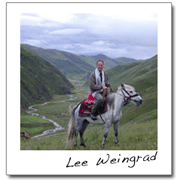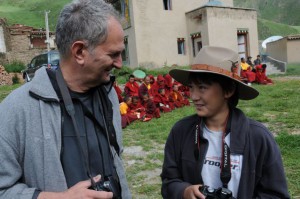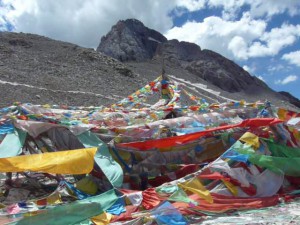Sunday
VCTR TributesReborn in Tibet, 2
A Retrospective Memoir, Part 2
by Lee Weingrad
“Sometimes you meet your fate on the road you took to avoid it.”
~~ Clive Owen’s character in “The International”
The five mile walk crossing the Tibet-Nepal border over the path that connected the Chinese-built Friendship Highway to the border at Kassa, was a physical challenge and not exactly a time for self-reflection. But now almost 30 years later, from the tranquility of my living room couch in Beijing, it’s clear that the hike symbolized the whacky imbalance between my life in Boulder, my baggage and so-called motives to go to Surmang, and the reality of actually getting there. This was the icing on the cake to leaving my life in the West behind.
Back in 1982, the Carter administration’s bad economic management created out-of-control interest rates that just about killed the retail jewelry business, taking my downstream career as a gemstone merchant with it. Suddenly no one had any cash. And neither did I. So I found myself with stark choices for survival. I couldn’t seem to find a place in the securities business. So I sold cars. Selling cars was a bit of a come down after the Brioni-suit glamour of the gemstone trade. But it quickly segued to selling Hondas during a period when you had to place an order and wait 9 months to buy a 4 door Accord.
I got good at it and Boulder was the hottest market in the country. I had an advantage since I was one of the few who was not doing coke and drinking. I was into dharma practice, and following Rinpoche’s lead, I knew that there was some wider reality out there after the candles and incense were snuffed out. As good as it was, I knew that my life at Crouch Honda was a temporary patch. Going to Surmang provided the motive to actually save money and move on to the next chapter.
Rinpoche was living in Boulder and we were in the middle of its more intense, exciting times. There were over 1400 members of Karma Dzong in Boulder, making it one of Boulder’s largest “churches”. There was Kalapa Court, Rinpoche’s residence, where I cooked once a week. There was Kalapa Camp, the Regent’s residence. I was friends with the Regent in the mid-80s and we hung out together, went to the movies together.
There were seminars by Rinpoche and the Vajra Regent and Shambhala training, ballroom dance classes, weddings, ikebana classes, and meal service classes were happening all the time. There were big annual birthday galas for Rinpoche. I Iearned how to eat with the back of a fork – for me, a Jewish kid from Queens, this was the dark side of the moon. Did I mention Kyudo with Shibata Sensei? And if that wasn’t enough, there were ongoing visits by luminaries in Buddhism such as HH Karmapa, HH Dalai Lama, HH Dudjom Rinpoche, Shamar Rinpoche, Tai Situ Rinpoche, Jamgon Rinpoche, Orgyen Tulku, Kalu Rinpoche, and Kobun Chino. To many of the non-Buddhists I knew, we were respectfully referred to as “the community.” I sometimes felt that I had box seats to the Enlightenment World Series. Boulder was a good place to be in the 80’s.
By 1985, I could see that, despite the unbelievable dharmic array, my life in sales was not my calling and I wanted out. At the same time, Rinpoche had begun to withdraw from public life.
In connection with the Boulder-Lhasa Sister City Project, the US-China Friendship Association held a reception at Kalapa Court for the Chinese Ambassador Han and through Tanya Leontov I was invited. It was peculiar. I’d never met an ambassador before. He arrived at the Court with State Department security. With his white hair, tanned face and good looks, he looked like someone out of central casting. The backyard had Kalapa Court-level food and beverage service, just as we were taught. I had the good fortune to be introduced to the Consul for the Chicago Consulate, Mr. Jiang Guochang, who assured me that getting a visa to visit Tibet would be no problem. And he was later proven right.
Ambassador Han knew that this was Rinpoche’s house, but Rinpoche was neither downstairs nor in the reception line. Instead he sat in his study on the second floor. When the Ambassador was invited to see Rinpoche, he entered the house from the back yard and being shown the way upstairs, he realized that official protocol was at the breaking point. “Who is this Tibetan lama,” he asked, “that I have to go upstairs to see?”
All this went through my mind as my funky hired car dropped me and my two heavy duffel bags at the customs and immigration shack where the pavement ended about 5 miles from the Tibetan border. “Shack” would be an insult to all shacks. It was a lean-to with a table in front of it. When I got out, I had my Nepali visa stamped amid the clamor of a dozen men screaming in Nepali in shorts offering to carry my bags over the border.
As soon as I got my passport back, I chose a porter and agreed to a price, the two bags were on his back and he started the sprint over the mountain. He was gone.
Oops.
At various points over the mountain, I could see him with my two bags. Me with a day pack, he barefoot with my two duffel bags. I couldn’t keep up with him. With luck we met at the big gate that signals China. He gave me my bags, I paid him and entered Tibet. I had made it.
The big gate said, “Huanyin nin lai zhongguo!” Welcome to China!
I had American dollars and some Nepali rupees, but no renminbi yuan, the Chinese currency. I thought I would change money at a bank once I crossed into China. The problem was, I discovered China was two and a half hours ahead of Nepal and by the time I cleared Chinese customs and immigration, the banks had already closed hours before. Welcome to Tibet.
I remember a big crowded dining hall and being one of very, very few foreigners. I took a walk after dinner and met another American, a doctor, who like me was traveling to Lhasa. He was a self-described “seasoned traveler,” and that appealed to me. The next morning we hired a Land Cruiser that had just dropped tourists off at the border. It was a way that the drivers could earn extra unreported money. I remember the trip in snapshots – the lush green as we hit valleys and canyons.
 It was exhilarating. My fellow traveler on the other hand, became a whining bitch before my very eyes and was constantly pushing the drivers. I don’t remember the details, but very soon it was clear that the Tibetan drivers thought he was an asshole also, and stopped talking to him.
It was exhilarating. My fellow traveler on the other hand, became a whining bitch before my very eyes and was constantly pushing the drivers. I don’t remember the details, but very soon it was clear that the Tibetan drivers thought he was an asshole also, and stopped talking to him.
The thing that stands out most of all was the stop at Yandrok Yumtso, the sacred lake of Central Tibet. It was very impressive, a deep aquamarine amidst snow-capped peaks. But I didn’t see Guru Rinpoche’s handprint. By this time, like the drivers, I was hardly talking to the “seasoned” traveler. Finally we arrived in Lhasa. Exiting the Land Cruiser, I remember vividly when my foot first touched the ground. “I know everything about this place,” I thought.
~~
 Lee Weingrad, also known as Wangli, was born in New York City and is a product of a middle class Jewish family and suburban New York City public schools. In 1972 he met Chogyam Trungpa Rinpoche and has been a student of his ever since. In 1986 he took his first trip to abroad: to Tibet, journeying overland from the Nepal border. He lives with his wife Wang Wenjing and children in Beijing. Meeting Trungpa Rinpoche’s eldest son, Sakyong Mipham Rinpoche, in Kathmandu, the two decided to form Friends of Surmang, to bring some help to Surmang Tibetans in the form of clinics, hospitals and other kinds of community development. Lee has transitioned away from English teaching to concentrate on the Surmang Foundation’s work fulltime. Learn more about the Surmang Foundation here.
Lee Weingrad, also known as Wangli, was born in New York City and is a product of a middle class Jewish family and suburban New York City public schools. In 1972 he met Chogyam Trungpa Rinpoche and has been a student of his ever since. In 1986 he took his first trip to abroad: to Tibet, journeying overland from the Nepal border. He lives with his wife Wang Wenjing and children in Beijing. Meeting Trungpa Rinpoche’s eldest son, Sakyong Mipham Rinpoche, in Kathmandu, the two decided to form Friends of Surmang, to bring some help to Surmang Tibetans in the form of clinics, hospitals and other kinds of community development. Lee has transitioned away from English teaching to concentrate on the Surmang Foundation’s work fulltime. Learn more about the Surmang Foundation here.




Apr 19, 2013
Reply
I’m enjoying your series.
Apr 14, 2013
Reply
GREAT READ!…and fun
I will be looking forward to episode 3.
Best Wishes to Lee and all,
Charles